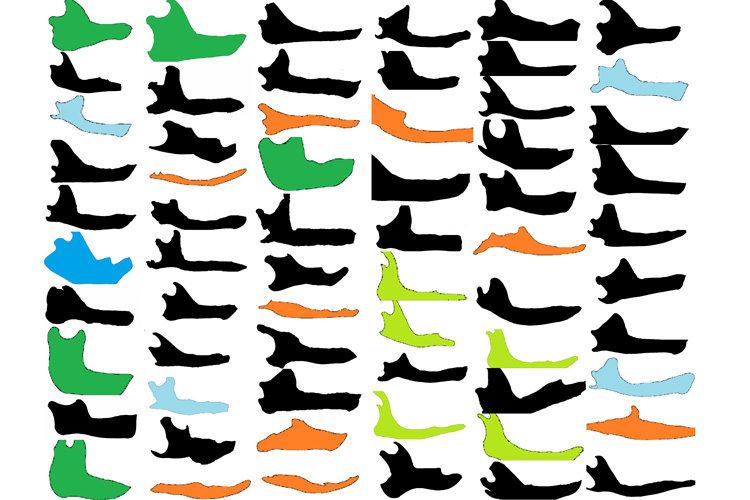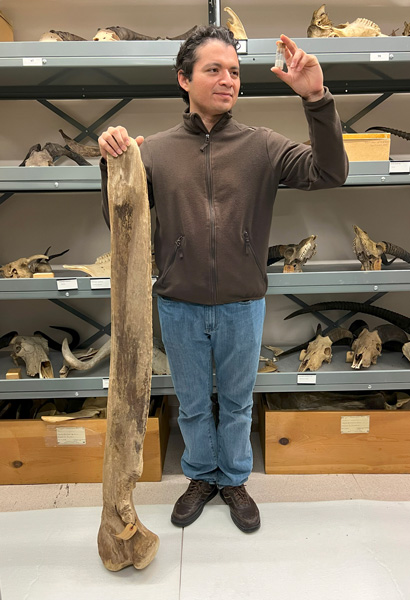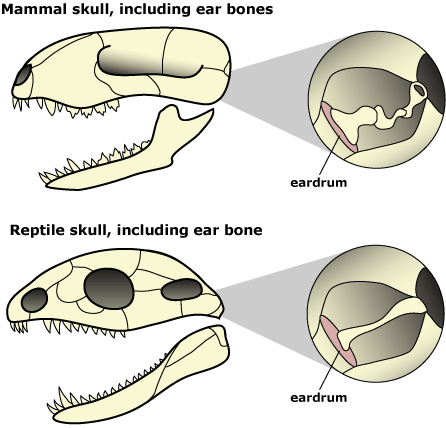A Jaw-Dropping Conundrum: Why Do Mammals Have a Stiff Lower Jaw?

From the 20-foot-long jawbones of the filter-feeding blue whale to the short, but bone-crushing, jaws of the hyena and the delicate chin bones of a human, the pair of lower jawbones characteristic of mammals have evolved with amazing variation.
But at first glance, having a single bone on each side of the head — which creates a stiff lower jaw, or mandible — doesn’t appear to give mammals an advantage over other vertebrates, which have at least two and as many as 11 bones comprising each side of the lower jaw.
Crocodiles, for example, have an edge over hyenas when it comes to their bite strength relative to size, despite having around five bones on each side of the jaw. Snakes, which have an articulated lower jaw with around four bones, are able to open their mouths larger for their size than baleen whales and actually dislocate their jaws to ingest prey larger than their heads. Even extinct hadrosaurs, or duckbill dinosaurs, with six bones in their jaw, could masticate plants using oral movements that were more complex than those of today’s cows.
So what advantage, if any, did two single jawbones — which in humans and other primates are fused at the chin into one solid mandible — give mammals?

That question motivated paleontologist Jack Tseng, assistant professor of integrative biology at the University of California, Berkeley, to construct a database of more than 1,000 vertebrate jaws — a small fraction of the approximately 66,000 living jawed vertebrate species on Earth — to systematically study whether mammalian jaws were a big advance over the multiply-boned jaws of fish, lizards, snakes and other non-mammals. He even printed 3D models of the lower jaws of many to test their sturdiness.
Surprisingly, the answer seems to be no — a lone lower jawbone on each side doesn’t have a huge advantage over a jaw with multiple bones.
“Should we interpret the innovation of the mammalian jaw as a pure adaptation that enabled, in all ways, mammals to be more successful after the dinosaurs went extinct? I think the answer is no,” Tseng said.
In fact, having multiple bones in the jaw gives an animal an advantage in biting: The bones may work together to provide flexibility and speed. Conversely, the single bone per side in mammals actually restricts the options available as mammals evolve. Paradoxically, this limitation has apparently not prevented mammals from adapting to eat and chew a variety of foods, rivaling the dietary diversity of vertebrates that have more than one bone in their jaw.
“There’s this idea of a trade-off between the additional flexibility and maybe additional speed that you could achieve with multiple bones in a jaw — which essentially compounds or enlarges movement — and the increased stiffness or increased bite strength when you have a single bone in the jaw,” Tseng said. “That sort of dichotomy between mammals and non-mammals supposedly enabled mammals to essentially become eaters of all things.”
But that has never been rigorously tested until now, Tseng said.
“Nobody’s tried to combine information from all of these groups of jawed vertebrates to ask general questions about how jaw shape and function are related,” he said.
In the end, he concluded, the structure of the jaw has less to do with the function of the jaw in vertebrates than one might expect.
“Mammal jaws are more diverse in shape, yet more constrained in their biomechanical characteristics, compared to non-mammals. Mammal jaws can take, on average, more different shapes compared to non-mammal jaws, but those different shapes have narrower range of different mechanical properties than non-mammals,” Tseng said. “This is a new observation that could potentially open up different ways of looking at mammal jaw biomechanics.”
“The main finding was that, yes, indeed, mammals, given their single-boned lower jaw, have significantly higher strength or stiffness on average compared to any non-mammal jaw,” he said. “This is true overall, regardless of what specific mammals are doing — it doesn’t matter if you are a carnivore or an herbivore. Stiffness is not a predator trait or herbivore trait, it’s a mammalian trait, a signature of the mammal jaw.”
Tseng’s study appeared last month in the journal Philosophical Transactions of the Royal Society B as part of a series on the evolution of the mammalian skull.
From jaw to ear
So why did mammals lose the extra bones in their lower jaw? Well, they didn’t. Instead, the extra bones that vertebrates had in the lower jaw, which were clustered around the hinge between the lower and upper jaw, evolved into the mammalian inner ear, perhaps giving mammals better hearing than their vertebrate cousins.

“A solid, stiff jaw in mammals is thought to be a side effect of establishing a uniquely mammalian hearing system,” Tseng said.
Coopting these jaw bones into the ear left mammals with only one lower jawbone per side, making for a rigid jaw that gave mammals some advantage in terms of stiffness — enough to crack bones, for example — but limited their descendants to variations on a single bone, even when a stiff lower jaw was not needed to eat soft food. Anteaters, for example, evolved a down-curving jaw that serves as a slot for their long tongue to slide through.
To date, this major evolutionary transition in mammals — to a complex inner ear, but simple jaw — has been studied primarily as it relates to the ear.
Tseng, who in the past has studied bone crushing animals like the hyena, wanted to look at the question from the jaw’s point of view and an engineering perspective. To do this, he digitized two-dimensional jaw shapes from more 1,000 kinds of vertebrates, established the key characteristics of vertebrate jaws, and then simulated the mechanical performance of different jaw shapes — including plausible shapes not seen in nature — to determine how mammals and non-mammals compared across the range of all possible jaws in terms of strength and function. He found that both groups spanned the range, and thus seem able to adapt to a similar range of strength and function. However, mammalian jaws cluster more around stiffer shapes than non-mammals’ jaws.

Tseng plans to expand his database to more vertebrate species and also incorporate 3D scans of jawbones for a better biomechanical assessment of stiffness and strength.
He also hopes that others will investigate the role genetics plays in mammals’ transition to a complex ear structure but a simple bone structure in the lower jaw, what the consequences of this transition were for mammalian evolution, and why evolution seems to have locked in this jaw trait in mammals.
“We hope our findings prompt some people to search for genetic bases for why this is a one-way street,” he said. “A next step is to understand in what ways this characteristic decoupling of structure and function in mammals helped them adapt to new environments during key geologic times, such as the extinction of non-avian dinosaurs, as well as appearances of land bridges connecting continents that allowed greater mixing of different ecological communities.”
Tseng’s co-authors are Sergio Garcia-Lara and Emily Holmes of UC Berkeley, John Flynn of the American Museum of Natural History in New York, Timothy Rowe of the University of Texas at Austin and Blake Dickson of Duke University in North Carolina.